Resistors are used in almost every electronic project.
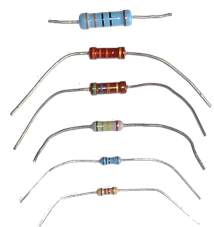
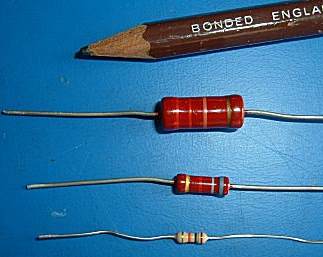
0.25watt 0.5watt and 1watt
resistors
They come in all sorts of
shapes and sizes.
The size you choose is determined by how hot they get in a circuit.
If no resistors in a project get hot, you can use any size. If a resistor
gets hot, use a larger size.
Always hold a resistor so the gold band is to the right.
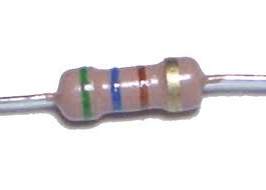
A 560R resistor
The gold band is the tolerance and lets you know the accuracy of
the resistor. No resistor can be made with an exact resistance
value and the gold band indicates the resistor is 5% higher or 5% lower than
the value shown on the 3 colour bands.
One of the most difficult things to identify in electronics is
the value of a resistor. They are all a mass of colour bands. The colour of
each band represents a number from 0 -
9.
COMMON VALUES
The resistors we use in our projects are called "common value"
4-band, 5% types.
The first three bands indicate the value of the resistor in ohms and the fourth band is called the "tolerance" band. Gold = 5%
(tolerance band Silver =10% but no modern resistors are 10%!! - they are 5%
or 1%)
"common resistors" have values 10 ohms to 22M and increment in
value by 10%.
RESISTORS LESS THAN 10 OHMS
When the third band is gold, it indicates the value of the "colours"
must be divided by 10.
Gold = "divide by 10" to get values 1R0 to 8R2
See 1st Column below for examples.
When the third band is silver, it indicates the value of the "colours"
must be divided by 100. (Remember: more letters in the word "silver" thus
the divisor is "a larger division.")
Silver = "divide by 100" to get values R1 to
R82
e.g: 0R1 = 0.1 ohm 0R22 = point 22 ohms
See 4th Column below for examples.
The letters "R, k and M" take the place of a decimal point.
e.g: 1R0 = 1 ohm 2R2 = 2 point 2 ohms 22R = 22
ohms
2k2 = 2,200 ohms 100k = 100,000 ohms
2M2 = 2,200,000 ohms
COLOUR CODE
HOW TO REMEMBER THE COLOUR CODE:
Each colour has a "number" (or divisor) corresponding to it.
Most of the colours are in the same order as in the spectrum. You can see
the spectrum in a rainbow. It is: ROYGBV and the colours for resistors are
in the same sequence.
black
brown - colour of increasing temperature
red
orange
yellow
green
blue
violet
gray
white
| colour |
value |
No of zero's |
| silver |
-2 |
divide by 100
* |
| gold |
-1 |
divide by 10 |
| black |
0 |
no zeros |
| brown |
1 |
0 |
| red |
2 |
00 |
| orange |
3 |
,000 or k |
| yellow |
4 |
0,000 |
| green |
5 |
00,000 |
| blue |
6 |
M |
| violet |
7 |
|
| gray |
8 |
|
| white |
9 |
|
*
- remember "silver" has more letters
than "gold" and that's why you divide by
100. |
Here are some common ways to remember the
colour code:
Bad Beer Rots Our Young Guts, But Vodka Goes Well
Bright Boys Rave Over Young Girls But Violet Gets Wed
Bad Boys Rave Over Young Girls But Violet Gets Wed with Gold and
Silver.
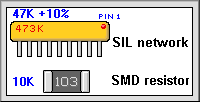
Alpha-Numeric Code Identification
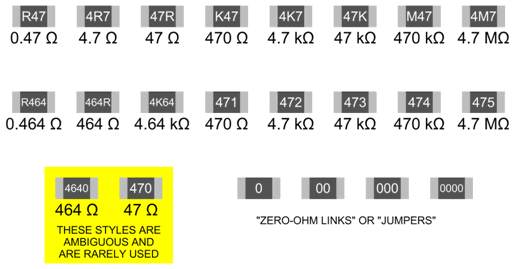
Some SM resistors have the letters "R" "k" and "M" to
help identification. The numbers "0" "00" are
zero ohm resistors for "links"
We have included 4 different colour codes for resistors. They are all the
same but some have better colours and explain some of the features better.
The last colour code shows the first three bands for all the resistors from
lee than 1 ohm to 10 meg ohms.
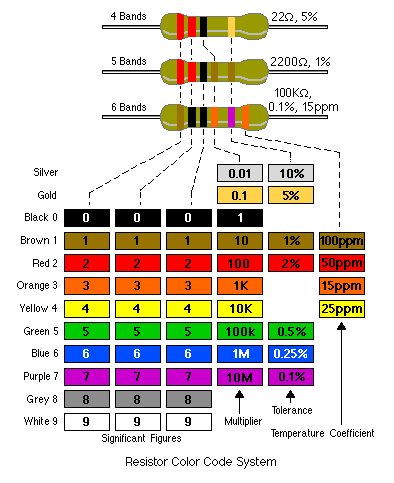
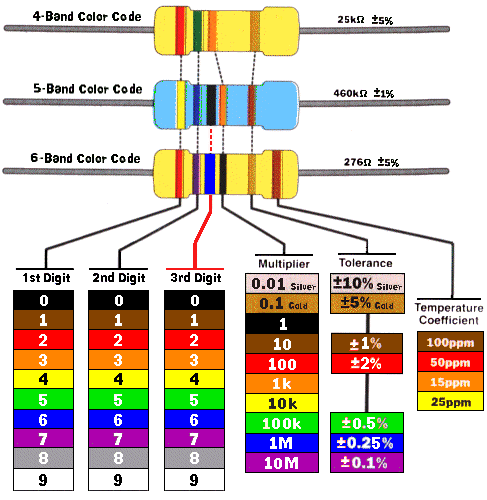
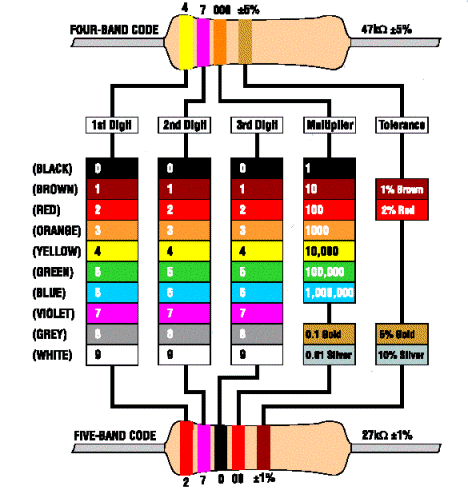

Resistors can be placed in SERIES or PARALLEL
When resistors are placed in SERIES, the total resistance is the addition of
each value. In the circuit below, the total resistance is 6k5
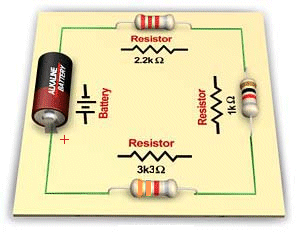
For resistors placed in parallel, the total is always less
than the smallest resistor. There is a formula for this but there is an easy
way to remember to simple examples. For two equal resistors placed in
parallel, the total resistance is HALF.
For 3 equal value resistors placed in parallel, the total is
one-third. In the circuit below, the total resistance is 330 Ohms.
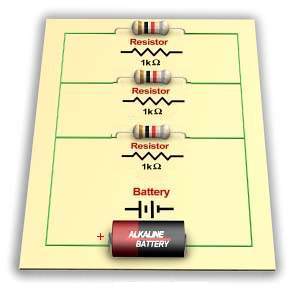
WHAT
RESISTORS "DO"
Here is a summary of resistor
characteristics etc:
Resistors "do" lots of different things in a circuit.
As you go though the projects on this website, the operation of each
component will be discussed.
Basically a resistor allows a small amount of current to flow, just like
putting your foot on a hose. The spray reduces.
But when this lower current is passed to other components, lots of different
effects can be created.
If the resistor feeds a capacitor, the capacitor charges up slowly. If the
resistor feeds a motor, the RPM reduces. Or a globe becomes dull. It can
also feed a transistor, a coil, a chip or combinations of these components.
That's why it becomes so complex.
The resistance of a resistor is measured in OHMS.
A piece of wire has zero ohms.
A gap between two wires has infinite ohms or INFINITE RESISTANCE.
A low value resistor may be 10 ohms. This is written 10R.
A high value resistor may be 1 meg ohms. This is written 1M.
You can make a 1 meg resistor by connecting one million 1ohm resistors in
series. But it is much easier to get a 1M resistor.
The size of a resistor is chosen so the resistor stays cool. If a resistor is getting
too hot, increase the size.
Size has nothing to do with its resistance. A small resistor can have a high
resistance and a large resistor can have a very small resistance.
There is a lot more to learn about resistors and resistance but it is very
technical. We have covered the most basic points.
24-5-2013
|










